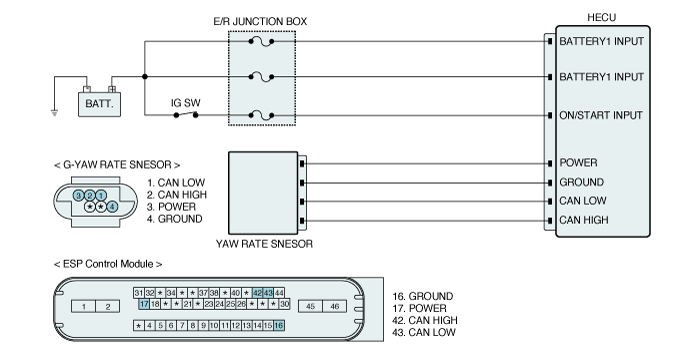Has a problem been found?
 | ▶ Repair as necessary and then go to "Verification of Vehicle Repair" procedure. |
 | ▶ Go to "Component Inspection" Procedure. |
When the vehicle is turning with respect to a vertical axis the yaw rate sensor detects the yaw rate electroniclly by the vibration change of plate fork inside the yaw rate sensor.
If yaw velocity reaches the specific velocity after it detects the vehicle' yawing, the ESP control is reactivated.
The later G sensor senses vehicle's lateral G. A small element inside the sensor is attached to a deflectable leverarm by later G.
Direction and magnitude of lateral G loaded to vehicle can be known with electrostatic capacity changing according to lateral G.
It interchanges signals with HECU through extra CAN line which only used for communication between HECU and sensor.
The HECU checks the sensor CAN H/W for normal ESP control, and sets this code if a sensor CAN H/W malfunction is detected.
Item | Detecting Condition | Possible cause |
DTC Strategy | ● Internal Monitoring | ● Faulty HECU ● Faulty Yaw Rate & Lateral G sensor |
Enable Conditions | ● Sensor CAN H/W failure. | |
Fail Safe | ● Inhibit the ESP control and allow the ABS/EBD control. ● The ESP warning lamp is activated. |

Many malfunctions in the electrical system are caused by poor harness(es) and terminal condition. Faults can also be caused by interference from other electrical systems, and mechanical or chemical damage.
Thoroughly check connectors for looseness, poor connection, bending, corrosion, contamination, deterioration, or damage.
Has a problem been found?
 | ▶ Repair as necessary and then go to "Verification of Vehicle Repair" procedure. |
 | ▶ Go to "Component Inspection" Procedure. |
Ignition "OFF" & Engine "OFF".
Ignition "ON" & Engine "OFF".
Connect scantool and select "Diagnostic Trouble Codes(DTCs)" mode.
Using a scantool, Clear DTC.
Select "Diagnostic Trouble Codes(DTCs)" mode again.
Are any DTCs present ?
 | ▶ Substitute with a known-good HECU and check for proper operation. If problem is corrected, replace HECU and then go to "Verification of Vehicle Repair" procedure. |
 | ▶ Fault is intermittent caused by faulty HECU or was repaired and HECU memory was not cleared. Go to "Verification of Vehicle Repair" procedure. |
After a repair, it is essential to verify that the fault has been corrected.
Connect scantool and select "Diagnostic Trouble Codes(DTCs)" mode
Using a scantool, Clear DTC.
Operate the vehicle within DTC Detecting Condition in General Information.
Using a scantool, Check DTC present.
Are any DTCs present ?
 | ▶ Go to the applicable troubleshooting procedure. |
 | ▶ System performing to specification at this time. |